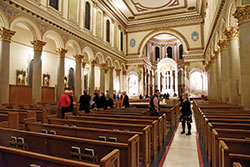Restoration work highlights beauty of St. Joan of Arc Church

Visitors appreciate the restoration work done to St. Joan of Arc Church during an open house on Dec. 11, 2019. The $2.2 million phase of the project regarding the interior of the church sought to enhance its beauty. The parish’s current church was completed in 1929. (Photo by Sean Gallagher)
By Sean Gallagher
When St. Joan of Arc Parish in Indianapolis was founded in 1921, its first parishioners faced social pressure from the anti-Catholic Ku Klux Klan, who opposed the spread of the Church into the growing northside of the city.
Undaunted by the Klan’s sway among the city and state’s political leaders, St. Joan of Arc’s parishioners were determined to build an impressive church that could not be ignored.
The parish’s current church was completed in 1929. It was modeled on a classical Roman basilica design and features a prominent bell tower. Its interior is just as impressive, marked by a massive baldachino, a stone canopy held aloft over its high altar by Italian marble columns. The canopy and columns have a combined weight of 65 tons.
“They built a big Roman basilica to show that the Catholics were here to stay,” said Father Guy Roberts, St. Joan of Arc’s pastor since 2006.
Nearly 100 years later, the interior of St. Joan of Arc Church required significant restoration work to preserve its beauty for current and future generations of worshippers.
Although the restoration work was completed last fall, discussion about its necessity dates back to 2007. Current parish council president Dr. Scott Rosenfeld was on the council then and has helped lead the restoration project since its inception.
During an open house in December 2019 to show off the $2.2 million phase of the project regarding the interior, Rosenfeld spoke with pride of his parish’s church.
“It’s very gratifying to see it,” he said. “It’s very emotional to come into this space when it’s been restored, to know where we were and what it was like. It’s so much brighter and so much more welcoming than it was before.”
The restoration work, which was begun in February 2019, included repainting the church’s walls and ceiling while maintaining its original images, installing new and updated lighting and a terrazzo floor, and restoring its historic Stations of the Cross paintings.
“When we talked about what we should do, we really wanted to highlight and maintain the historical structure of the church,” Rosenfeld noted. “We did not want to change it.”
Much of the beauty of the church that was there from its beginning was difficult to appreciate because of its poor lighting and color scheme. That is no longer the case.
“The only lights that have really been added are the lights behind the altar,” Rosenfeld said. “Everything else existed in some form. They’ve just been upgraded, and there’s more reflectiveness on the surfaces in the church to get more reflective light.”
Lifelong parishioner Rita Welch spoke with pleasure of her parish church during the open house.
“You can look at the Stations of the Cross and actually see what they look like from a distance,” said Welch, 66. “They’re not dark and dingy. It’s all just so beautiful.”
Walking in the church on a dark December night and still being able to view its beauty in its fullness brought back memories for Welch.
“It just gives you a fresh new look,” she said. “I can remember as a little kid staring at the ceiling and looking at its details. Now I can do it again, and more so.”
Father Roberts is glad that parishioners with longstanding ties to the Indianapolis North Deanery faith community appreciate the restoration work. But he is also looking forward to its future.
In recent years, many new, young Catholic families have moved into the neighborhood around St. Joan of Arc. The parish has also attracted many new members from well beyond its near northside neighborhood.
The diversity of its members is both a blessing and challenge, Father Roberts said.
“Anybody can come to Joan of Arc and feel welcomed,” he said. “But that also has a drawback. It’s been hard to form a community with a single or unifying purpose.”
The restoration project and the $5 million capital campaign to fund it, previous work to the church’s heating, ventilating and air-conditioning system, and future work to the church’s windows and front steps has been a catalyst to bring its diverse parishioners closer together.
“This was something that they had to work on collectively,” Father Roberts said. “People are now looking around and saying, ‘Wow. We did this.’ It’s been a good community builder. There’s a sense of pride. This is truly their parish home.”
While he has focused much attention on restoring the parish’s physical worship space, Father Roberts did not want it to “just be a museum piece.”
“That was one of my concerns,” he said. “Are we just fixing up this building so we can say that we preserved this building for tourists? But we are truly a living community. I think the restoration has been indicative of the spiritual renewal in this community.”
Father Roberts sees that renewal in the baptisms of babies he celebrates nearly every week of the year.
As the parish prepares to celebrate its centennial next year, Father Roberts hopes that the restored church will foster the faith of babies he has baptized and other young people who come to St. Joan of Arc.
“I’m hoping that it will be a doorway to ask more questions about the faith,” he said, “and instill a sense of pride and interest in the children so they will continue to pass the faith on.” †
